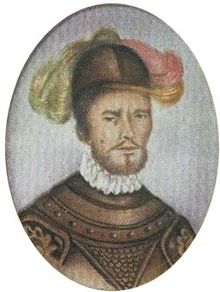Pedro de Ursúa
Pedro de Ursúa (* around 1525 probably in Arizcun; † January 1, 1561 ) was a Spanish conquistador who was murdered by his soldiers as the leader of an expedition in search of the golden land of Eldorado .
resume
Ursúa came from a Basque noble family who had their ancestral home in Arizcun in Navarre , Spain . His exact date of birth is unknown and there is no news about his childhood either.
In 1543 he came to Spanish America, where he was patronized by an influential relative, so that in 1544 he was deputy governor of the Santa Fe de Bogotá region . During the civil war in the viceroyalty of Peru between the viceroy Blasco Núñez de Vela and Gonzalo Pizarro , he supported the former, then participated in the subjugation of Indian tribes . In 1552 he was appointed Chief Justice of the City of Santa Marta , but in 1553 he was recalled from the post for excessive cruelty in fighting Indians. In 1554 an arrest warrant was issued against him in Peru because it was suspected that he wanted to join the Hernández Girón rebellion with his soldiers . Presumably on his way back to Spain, he received an assignment in Panama to fight a group of fugitive African slaves. He did this job by inviting the cimarrones to negotiate and then killing them with poisoned wine. As a reward for this act, after his return to Peru, he was given the leadership of an expedition to the kingdom of the Omagua , where the legendary gold country Eldorado was suspected at the time. Ursúa had recently become engaged to the young widow Inés de Atienza; this accompanied him on the expedition.
Amazon expedition to search for the Eldorado
The conquistadors Francisco de Orellana and Philipp von Hutten had reported decades earlier about cities in the middle of the jungle. The supposed kingdom of the Omagua could never be found. It is believed that the reports of the first conquistadors were either greatly exaggerated or that the settlements actually sighted by them were deserted as a result of diseases introduced by the Spaniards.
Ursúa's expedition was delayed several times for lack of money, although the viceroy's administration had granted a larger grant. This caused Ursúa to resort to dubious methods. For example, by threatening to use force, he compelled Pastor Pedro Portillo to contribute a larger sum to finance the expedition. In order to prevent a criminal complaint from the royal judiciary, he forced Portillo as well as the Alcalden Alonso de Montoya to participate in the expedition. On February 26 or 27, 1560 Ursúa set out with 300 armed Spaniards, several hundred Indian helpers, 20 African slaves and 27 horses.
The expedition was joined from the beginning by numerous unemployed soldiers who came away empty-handed during the conquest of Peru and were dissatisfied with the viceroyal rule. Ursúa was warned against leaving and including several well-known troublemakers on the expedition, but ignored this.
When the expedition reached the middle reaches of the Amazon by ship in November 1560, nothing of the promised gold country could be seen. A veteran from Orellana's Amazon expedition said he did not recognize the area. For days the expedition drove through completely deserted jungle. As food became scarce and several people died of hunger, dissatisfaction spread among the expedition members. A group of conspirators led by the Basque conquistador Lope de Aguirre took advantage of this mood for a mutiny . They killed Ursúa on the night of January 1st, 1561 and appointed the Andalusian nobleman Fernando de Guzmán as the new leader of the expedition. The conspirators intended to return to Peru, overthrow the viceroy and proclaim Guzmán king of Peru. This goal turned out to be unfeasible and the expedition ended in disaster under Aguirre's leadership (described in the article on Lope de Aguirre).
Inés de Atienza was also murdered a few months later on the instructions of Aguirre.
In various literary adaptations of the Lope de Aguirres rebellion, he is portrayed as a mad murderer, while Ursúa is portrayed as a chivalrous nobleman.
literature
- Ingrid Galster : Aguirre or the arbitrariness of posterity. The rebellion of the Basque conquistador Lope de Aguirre in Historiography and Historical Fiction (1561–1992) , Vervuert Verlag, 1996, ISBN 3-89354-075-X .
- Ingrid Galster: Aguirre o La posteridad arbitraria. La rebelión del conquistador vasco Lope de Aguirre en historiografía y ficción histórica (1561-1992) , Ed. Universidad del Rosario and Ed. Universidad Javeriana, Bogotá 2011, ISBN 978-958-738-204-4 (also available as an e-book).
- Alfred Antkowiak: El Dorado. The Search for Goldland , Volk und Welt Verlag, 1976.
| personal data | |
|---|---|
| SURNAME | Ursúa, Pedro de |
| BRIEF DESCRIPTION | Spanish conquistador |
| DATE OF BIRTH | around 1525 |
| PLACE OF BIRTH | Arizcun , Navarre Province |
| DATE OF DEATH | January 1, 1561 |
